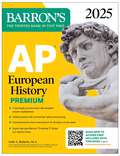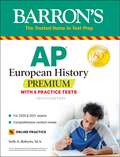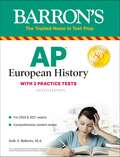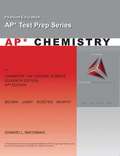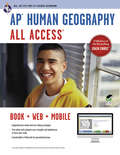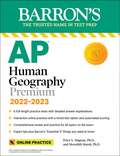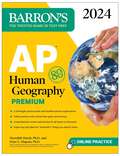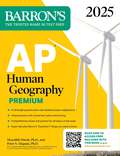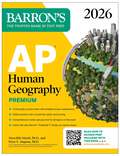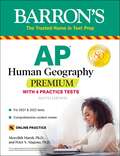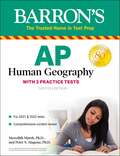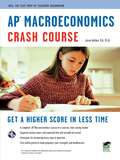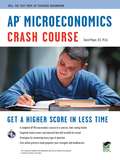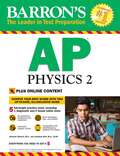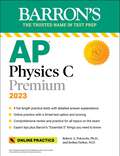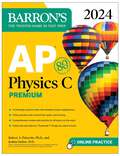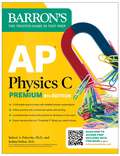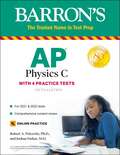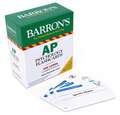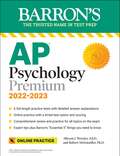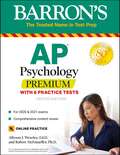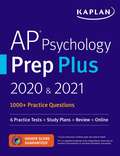- Table View
- List View
AP European History Premium, 2025: Prep Book with 5 Practice Tests + Comprehensive Review + Online Practice (Barron's AP Prep)
by Seth A. Roberts M.A.Be prepared for exam day with Barron&’s. Trusted content from AP experts! Barron&’s AP European History Premium, 2025 includes in‑depth content review and online practice. It&’s the only book you&’ll need to be prepared for exam day.Written by Experienced Educators Learn from Barron&’s‑‑all content is written and reviewed by AP experts Build your understanding with comprehensive review tailored to the most recent exam Get a leg up with tips, strategies, and study advice for exam day‑‑it&’s like having a trusted tutor by your side Be Confident on Exam Day Sharpen your test‑taking skills with 5 full‑length practice tests–2 in the book and 3 more online–plus detailed answer explanations, sample responses, and scoring guidelines for all questions Strengthen your knowledge with in‑depth review covering all Units on the AP European History Exam Reinforce your learning with long essay, short-answer, and multiple-choice practice questions at the end of each chapter Determine which topics you know well and which you need to brush up on with comprehensive practice assessments for each major time period in European History Robust Online Practice Continue your practice with 3 full‑length practice tests on Barron&’s Online Learning Hub Simulate the exam experience with a timed test option Deepen your understanding with detailed answer explanations and expert advice Gain confidence with scoring to check your learning progress Going forward, this exam will only be offered in a digital format. Barron's AP online tests offer a digital experience with a timed test option to get you ready for test day. Visit the Barron's Learning Hub for more digital practice.
AP European History Premium, Fourteenth Edition: Prep Book with 5 Practice Tests + Comprehensive Review + Online Practice (Barron's AP Prep)
by Seth A. Roberts M.A. Barron's Educational SeriesBe prepared for exam day with Barron&’s. Trusted content from AP experts! Barron&’s AP European History Premium, Fourteenth Edition includes in‑depth content review and online practice. It&’s the only book you&’ll need to be prepared for exam day.Written by Experienced Educators Learn from Barron&’s‑‑all content is written and reviewed by AP experts Build your understanding with comprehensive review tailored to the most recent exam Get a leg up with tips, strategies, and study advice for exam day‑‑it&’s like having a trusted tutor by your side Be Confident on Exam Day Sharpen your test‑taking skills with 5 full‑length practice tests–2 in the book and 3 more online–plus detailed answer explanations, sample responses, and scoring guidelines for all questions Strengthen your knowledge with in‑depth review covering all Units on the AP European History Exam Reinforce your learning with long essay, short-answer, and multiple-choice practice questions at the end of each chapter Robust Online Practice Determine which topics you know well and which you need to brush up on with comprehensive practice assessments for each major time period in European History Continue your practice with 3 full‑length practice tests on Barron&’s Online Learning Hub Simulate the exam experience with a timed test option Deepen your understanding with detailed answer explanations and expert advice Gain confidence with scoring to check your learning progress Publisher's Note: Products purchased from 3rd party sellers are not guaranteed by the publisher for quality, authenticity, or access to any online entities included with the product.
AP European History Premium: With 5 Practice Tests (Barron's Test Prep)
by Seth A. Roberts M.A.Written by a classroom AP European History teacher who has taught both in the U.S. and abroad, Barron’s AP European History Premium is updated to reflect the latest scoring rubrics and exam framework. You’ll get the comprehensive content review and practice you need to be prepared for the exam.This premium edition features: Two full-length practice tests in the book to help you apply the knowledge you learned in class. Three full-length practice tests online. A comprehensive review of European history, starting with Europe during the Italian Renaissance and progressing to Europe in the twenty-first century. Practice multiple-choice, short-answer, and essay questions with answers following each chapter. Extensive charts that summarize Europe's history. Content presented in easily digestible bulleted lists, peppered throughout commentary text. This edition has been refined to closely match the exam content now that the new course curriculum has been in practice for two full academic years.
AP European History: With 2 Practice Tests (Barron's Test Prep)
by Seth A. Roberts M.A.Written by a classroom AP European History teacher who has taught both in the U.S. and abroad, Barron’s AP European History is updated to reflect the latest scoring rubrics and exam framework. You’ll get the comprehensive content review and practice you need to be prepared for the exam. This edition features:Two full-length practice tests to help you apply the knowledge you learned in class. A comprehensive review of European history, starting with Europe during the Italian Renaissance and progressing to Europe in the twenty-first century. Practice multiple-choice, short-answer, and essay questions with answers following each chapterExtensive charts that summarize Europe's history. Content presented in easily digestible bulleted lists, peppered throughout commentary text. This edition has been refined to closely match the exam content now that the new course curriculum has been in practice for two full academic years.
AP Exam Workbook for Chemistry: The Central Science, 11th edition
by Edward Waterman Theodore E. Brown Stephen A. Lemay Brad BrownAdvanced Placement Chemistry is more than just a course in first-year college general chemistry. Whether or not your AP exam score qualifies you for college credit, there are many advantages of taking Advanced Placement Chemistry. It is an opportunity, while you're still in high school, to prepare for college by challenging yourself with rigorous college-level work. Your classmates will often be some of the best and brightest students at your school and the peer group you study with will enhance your own abilities as a student. It is likely that your teacher will be among the best at your school and he or she will have invaluable knowledge and insight. Besides acquiring advanced knowledge of chemistry, the science central to all other scientific disciplines, you will also develop your skills in analytical thinking, abstract reasoning, problem solving and effective communication. You will enhance your study skills, both as an individual and within a group, and you will increase your own ability to learn how to learn. A second year of chemistry in high school will give you a decided competitive advantage over your future college classmates who have not taken Advanced Placement classes in high school. Advanced Placement Chemistry can serve as a measure of "survival insurance" for that upcoming pivotal year in life: the first year of college.
AP Human Geography All Access
by Christian SawyerAP Human Geography All Access - Book + Web + Mobile Everything you need to prepare for the Advanced Placement exam, in a study system built around you! This AP All Access book, and the free online tools that come with it, help you personalize your AP Human Geography prep by testing your understanding, pinpointing your weaknesses, and delivering flashcard study materials unique to you. Review the Book: Study the topics tested on the AP Human Geography exam and learn AP strategies that will help you tackle any question you may see on test day. Visit The REA Study Center for online tools: At the REA Study Center, you can access quizzes, mini-tests, and a full-length practice test. Each of these tools provides true-to-format questions and delivers a detailed score report that follows the topics set by the College Board. Quizzes: 15-minute online quizzes test your immediate grasp of the topics just covered. Mini-Tests: 2 online mini-tests cover what you've studied in each half of the book. These tests evaluate your overall understanding of the subject. Full-Length Practice Test: Take our full-length exam to practice under test-day conditions. Available both in the book and online, this test gives you the most complete picture of your strengths and weaknesses. The online version of the exam includes timed testing, automatic scoring, and a detailed score report. e-Flashcards: With your score reports from the quizzes and tests, you can see which AP Human Geography topics you need to review. Use this information to create flashcards for the areas where you are weak and study them from any computer or smartphone. Get started with the 100 cards included with this book. AP All Access is a must-have for students taking the Advanced Placement AP Human Geography exam.
AP Human Geography Premium, 2022-2023: 6 Practice Tests + Comprehensive Review + Online Practice (Barron's Test Prep)
by Peter S. Alagona Meredith Marsh Ph.D.Be prepared for exam day with Barron&’s. Trusted content from AP experts! Barron&’s AP Human Geography Premium: 2022-2023 includes in-depth content review and online practice. It&’s the only book you&’ll need to be prepared for exam day.Written by Experienced Educators Learn from Barron&’s--all content is written and reviewed by AP expertsBuild your understanding with comprehensive review tailored to the most recent exam Get a leg up with tips, strategies, and study advice for exam day--it&’s like having a trusted tutor by your sideBe Confident on Exam DaySharpen your test-taking skills with more practice in this updated edition!6 full-length practice tests--3 in the book, including a new diagnostic test to target your studying, and 3 more onlineStrengthen your knowledge with in-depth review covering all Units on the AP Human Geography ExamReinforce your learning with practice questions at the end of each chapter Online PracticeContinue your practice with 3 full-length practice tests on Barron&’s Online Learning HubSimulate the exam experience with a timed test option Deepen your understanding with detailed answer explanations and expert adviceGain confidence with scoring to check your learning progress
AP Human Geography Premium, 2024: 6 Practice Tests + Comprehensive Review + Online Practice (Barron's AP)
by Peter S. Alagona Meredith Marsh Ph.D.Power up your study sessions with Barron's AP Human Geography on Kahoot!-- additional, free prep to help you ace your exam!Be prepared for exam day with Barron&’s. Trusted content from AP experts!Barron&’s AP Human Geography Premium, 2024 includes in-depth content review and online practice. It&’s the only book you&’ll need to be prepared for exam day.Written by Experienced Educators Learn from Barron&’s--all content is written and reviewed by AP expertsBuild your understanding with comprehensive review tailored to the most recent exam Get a leg up with tips, strategies, and study advice for exam day--it&’s like having a trusted tutor by your sideBe Confident on Exam DaySharpen your test-taking skills with more practice in this updated edition!6 full-length practice tests--3 in the book, including a new diagnostic test to target your studying, and 3 more onlineStrengthen your knowledge with in-depth review covering all Units on the AP Human Geography ExamReinforce your learning with practice questions at the end of each chapter Online PracticeContinue your practice with 3 full-length practice tests on Barron&’s Online Learning HubSimulate the exam experience with a timed test option Deepen your understanding with detailed answer explanations and expert adviceGain confidence with scoring to check your learning progress
AP Human Geography Premium, 2025: Prep Book with 6 Practice Tests + Comprehensive Review + Online Practice (Barron's AP Prep)
by Peter S. Alagona Meredith Marsh Ph.D.Be prepared for exam day with Barron&’s. Trusted content from AP experts! Barron&’s AP Human Geography Premium, 2025 includes in‑depth content review and practice. It&’s the only book you&’ll need to be prepared for exam day. Written by Experienced Educators Learn from Barron&’s‑‑all content is written and reviewed by AP experts Build your understanding with comprehensive review tailored to the most recent exam Get a leg up with tips, strategies, and study advice for exam day‑‑it&’s like having a trusted tutor by your side Be Confident on Exam Day Sharpen your test‑taking skills with 6 full‑length practice tests–3 in the book, including a diagnostic test to target your studying, and 3 more online –plus detailed answer explanations for all questions Strengthen your knowledge with in‑depth review covering all units on the AP Human Geography exam Reinforce your learning with multiple-choice and free-response practice questions at the end of each chapter, all accompanied by clear answers and explanations Learn to think geographically by reviewing key terms and their definitions, detailed maps and graphs, end-of-chapter summaries, and much more Robust Online Practice Continue your practice with 3 full‑length practice tests on Barron&’s Online Learning Hub Simulate the exam experience with a timed test option Deepen your understanding with detailed answer explanations and expert advice Gain confidence with scoring to check your learning progress Power up your study sessions with Barron's AP Human Geography on Kahoot!‑‑ additional, free practice to help you ace your exam!
AP Human Geography Premium, 2026: Prep Book with 6 Practice Tests+ Comprehensive Review + Online Practice (Barron's AP Prep)
by Peter S. Alagona Meredith Marsh Ph.D. Barron's Educational SeriesBe prepared for exam day with Barron&’s. Trusted content from AP experts! Barron&’s AP Human Geography Premium, 2026 includes in‑depth content review and practice. It&’s the only book you&’ll need to be prepared for exam day. Written by Experienced Educators Learn from Barron&’s‑‑all content is written and reviewed by AP experts Build your understanding with comprehensive review tailored to the most recent exam Get a leg up with tips, strategies, and study advice for exam day‑‑it&’s like having a trusted tutor by your side Be Confident on Exam Day Sharpen your test‑taking skills with 6 full‑length practice tests–3 in the book, including a diagnostic test to target your studying, and 3 more online –plus detailed answer explanations for all questions Strengthen your knowledge with in‑depth review covering all units on the AP Human Geography exam Reinforce your learning with multiple-choice and free-response practice questions at the end of each chapter, all accompanied by clear answers and explanations Learn to think geographically by reviewing key terms and their definitions, detailed maps and graphs, end-of-chapter summaries, and much more Robust Online Practice Continue your practice with 3 full‑length practice tests on Barron&’s Online Learning Hub Simulate the exam experience with a timed test option Deepen your understanding with detailed answer explanations and expert advice Gain confidence with scoring to check your learning progress Power up your study sessions with Barron's AP Human Geography on Kahoot!‑‑ additional, free practice to help you ace your exam!Publisher's Note: Products purchased from 3rd party sellers are not guaranteed by the publisher for quality, authenticity, or access to any online entities included with the product.
AP Human Geography Premium: With 4 Practice Tests (Barron's Test Prep)
by Peter S. Alagona Meredith Marsh Ph.D.Barron&’s AP Human Geography Premium: With 4 Practice Tests is fully revised to align with the College Board changes for the May 2020 exam. You&’ll get in-depth content review and revised practice tests to help you feel prepared for the new exam. This edition includes:Content aligned with the AP course, including updates to the first section of the test, the multiple-choice section, and the score weightingThree full-length practice tests onlineTwo full-length practice tests in the bookOne diagnostic test to help students target areas where they need more studySubject review covering map reading and understanding scale, population geography, cultural geography, political geography, economic geography, agricultural and rural geography, and urban geography
AP Human Geography: A Study Guide, 3rd Edition
by Ethel WoodThis 3rd edition of the study guide prepares students for the AP Human Geography Exam. The book includes narrative reviews for each of the topic areas of the AP Human Geography curriculum, and each unit is followed by all new multiple-choice and free-response questions. Two sample exams follow, with each consisting of 75 all new multiple-choice questions and three new free-response questions.
AP Human Geography: with 2 Practice Tests (Barron's Test Prep)
by Peter S. Alagona Meredith Marsh Ph.D.Barron&’s AP Human Geography: With 3 Practice Tests is fully revised to align with the College Board changes for the May 2020 exam. You&’ll get in-depth content review and revised practice tests to help you feel prepared for the new exam.This edition includes:Content aligned with the AP course, including updates to the first section of the test, the multiple-choice section, and the score weightingTwo full-length practice exams in the book with answers and explanationsOne diagnostic test to help students target areas where they need more studySubject review covering map reading and understanding scale, population geography, cultural geography, political geography, economic geography, agricultural and rural geography, and urban geography
AP Macroeconomics Crash Course
by Jason WelkerAP Macroeconomics Crash Course - Gets You a Higher Advanced Placement Score in Less Time Crash Course is perfect for the time-crunched student, the last-minute studier, or anyone who wants a refresher on the subject. AP Macroeconomics Crash Course gives you: Targeted, Focused Review - Study Only What You Need to Know Crash Course is based on an in-depth analysis of the AP Macroeconomics course description outline and actual AP test questions. It covers only the information tested on the exam, so you can make the most of your valuable study time. Our easy-to-read format covers basic economic concepts, economic performance, inflation, price determination, unemployment, economic growth, and more. The author includes must-know key formulas and definitions all AP students should know before test day. Expert Test-taking Strategies An AP Macroeconomics teacher shares detailed question-level strategies and explains the best way to answer the multiple-choice and free-response questions you'll encounter on test day. By following our expert tips and advice, you can boost your overall point score. Take REA's Online Practice Exam After studying the material in the Crash Course, go online and test what you've learned. Our practice exam features timed testing, diagnostic feedback, detailed explanations of answers, and automatic scoring. The exam is balanced to include every topic and type of question found on the actual AP exam, so you know you're studying the smart way. Whether you're cramming for the test at the last minute, looking for extra review, or want to study on your own in preparation for the exam - this is one study guide every AP Macroeconomics student must have.
AP Microeconomics Crash Course
by David MayerAP Microeconomics Crash Course - Gets You a Higher Advanced Placement Score in Less Time REA's Crash Course is perfect for the time-crunched student, the last-minute studier, or anyone who wants a refresher on the subject. Our AP Microeconomics Crash Course gives you: Targeted, Focused Review - Study Only What You Need to Know Crash Course is based on an in-depth analysis of the AP Microeconomics course description outline and actual AP test questions. It covers only the information tested on the exam, so you can make the most of your valuable study time. Our easy-to-read format covers: basic economic concepts, consumer choice theory, supply and demand, production and costs, and more. The author also includes must-know key terms all AP students should know before test day. Expert Test-taking Strategies An AP Microeconomics teacher shares detailed question-level strategies and explains the best way to answer the multiple-choice and free-response questions you'll encounter on test day. By following our expert tips and advice, you can boost your overall point score. Take REA's Online Practice Exam After studying the material in the Crash Course, go online and test what you've learned. Our practice exam features timed testing, diagnostic feedback, detailed explanations of answers, and automatic scoring. The exam is balanced to include every topic and type of question found on the actual AP exam, so you know you're studying the smart way. Whether you're cramming for the test at the last minute, looking for extra review, or want to study on your own in preparation for the exam - this is one study guide every AP Microeconomics student must have.
AP Physics 2 with Online Tests (Barron's Test Prep)
by Kenneth Rideout Jonathan Wolf M.A. Ed. MBarron&’s brand new AP Physics 2 with Online Tests provides four practice tests and key review for the AP Physics 2 exam. Content corresponds to the topics covered in a second-year, algebra-based physics class. AP Physics 2 helps students review electric, magnetic, and gravitational fields; circuits and capacitance; fluid dynamics; thermodynamics; optics; and modern physics.AP Physics 2 includes:Two practice tests in the book with all questions answered and explainedTwo online practice tests with all questions answered and explainedA diagnostic test in the book to help students target areas where they need more studyPractice questions and review covering all test areasTips and advice for dealing with the new problem types introduced on this test
AP Physics C Premium, 2023: 4 Practice Tests + Comprehensive Review + Online Practice (Barron's Test Prep)
by Robert A. Pelcovits Ph.D. Joshua Farkas M.D.Be prepared for exam day with Barron&’s. Trusted content from AP experts!Barron&’s AP Physics C: 2023 includes in-depth content review and online practice. It&’s the only book you&’ll need to be prepared for exam day.Written by Experienced Educators Learn from Barron&’s--all content is written and reviewed by AP expertsBuild your understanding with comprehensive review tailored to the most recent exam Get a leg up with tips, strategies, and study advice for exam day--it&’s like having a trusted tutor by your sideBe Confident on Exam DaySharpen your test-taking skills with 4 full-length practice tests--3 in the book and 1 more onlineStrengthen your knowledge with in-depth review covering all Units on the AP Physics C ExamReinforce your learning with practice questions at the end of each chapter Online PracticeContinue your practice with 1 full-length practice tests on Barron&’s Online Learning HubSimulate the exam experience with a timed test option Deepen your understanding with detailed answer explanations and expert adviceGain confidence with scoring to check your learning progress
AP Physics C Premium, 2024: 4 Practice Tests + Comprehensive Review + Online Practice (Barron's AP)
by Robert A. Pelcovits Ph.D. Joshua Farkas M.D.Be prepared for exam day with Barron&’s. Trusted content from AP experts!Barron&’s AP Physics C Premium, 2024 includes in-depth content review and online practice. It&’s the only book you&’ll need to be prepared for exam day.Written by Experienced Educators Learn from Barron&’s--all content is written and reviewed by AP expertsBuild your understanding with comprehensive review tailored to the most recent exam Get a leg up with tips, strategies, and study advice for exam day--it&’s like having a trusted tutor by your sideBe Confident on Exam DaySharpen your test-taking skills with 4 full-length practice tests--3 in the book and 1 more onlineStrengthen your knowledge with in-depth review covering all Units on the AP Physics C ExamReinforce your learning with practice questions at the end of each chapter Online PracticeContinue your practice with 1 full-length practice tests on Barron&’s Online Learning HubSimulate the exam experience with a timed test option Deepen your understanding with detailed answer explanations.Gain confidence with scoring to check your learning progress
AP Physics C Premium, Eighth Edition: 4 Practice Tests + Comprehensive Review + Online Practice (Barron's AP Prep)
by Robert A. Pelcovits Ph.D. Joshua Farkas M.D. Barron's Educational SeriesBe prepared for exam day with Barron&’s. Trusted content from AP experts! Barron&’s AP Physics C Premium, Eighth Edition is fully revised for the latest course and exam updates and includes in‑depth content review and practice. It&’s the only book you&’ll need to be prepared for exam day.Written by Experienced Educators Learn from Barron&’s‑‑all content is written and reviewed by AP experts Build your understanding with comprehensive review tailored to the most recent exams Get a leg up with tips, strategies, and study advice for exam day‑‑it&’s like having a trusted tutor by your side Be Confident on Exam Day Sharpen your test‑taking skills with 4 full‑length practice tests–3 in the book, including a diagnostic test to target your studying, and 1 more online–that mirror the latest exam format and question types plus detailed answer explanations for all questions Strengthen your knowledge with in‑depth review covering all recent course updates and the latest units on both the AP Physics C: Mechanics and AP Physics C: Electricity and Magnetism Exams Reinforce your learning with multiple-choice and free-response practice questions at the end of each chapter Enhance your problem-solving skills by reviewing hundreds of examples and detailed solutions that cover all frequently tested topics Online Practice Continue your practice with 1 full‑length practice test on Barron&’s Online Learning Hub Simulate the exam experience with a timed test option Deepen your understanding with detailed answer explanations and expert advice Gain confidence with scoring to check your learning progress Publisher's Note: Products purchased from 3rd party sellers are not guaranteed by the publisher for quality, authenticity, or access to any online entities included with the product.
AP Physics C: With 4 Practice Tests (Barron's Test Prep)
by Robert A. Pelcovits Ph.D. Joshua Farkas M.D.Updated and streamlined to reflect both the Mechanics section and the Electricity and Magnetism section of the most recent AP Physics C course and exam, this new edition presents:One full-length diagnostic test for students to diagnose their strengths and weaknesses on both sections Two full-length practice tests (with sections for Mechanics and Electricity and Magnetism that reflect the actual exam in terms of format, content tested, and level of difficulty) accompanied by fully explained answersOne additional full-length online exam (with sections for Mechanics and Electricity and Magnetism) and fully explained answers for all questionsA comprehensive review of all test topics (including kinematics, Newton&’s laws, simple harmonic motion, universal gravitation, magnetic fields, and much more)Detailed examples and practice questions for all major topicsAn appendix of Physics C equations and constants
AP Psychology Flashcards (Barron's Test Prep)
by Robert McEntarffer Ph.D. Allyson J. Weseley Ed.D.Learn the most frequently tested individuals, terms, and concepts from the AP Psychology course framework anywhere, anytime with this digital format that enhances memorization! The College Board has announced that there are May 2021 test dates available from May 3-7 and May 10-14, 2021. Barron&’s AP Psychology Flashcards includes 500 digital flashcards that cover the most frequently tested individuals, terms, and concepts from the following nine units of the AP Psychology course framework: Scientific Foundations of PsychologyBiological Bases of BehaviorSensation and PerceptionLearningCognitive PsychologyDevelopmental PsychologyMotivation, Emotion, and PersonalityClinical PsychologySocial PsychologyDigital flashcard features:Access anywhere: study on all devices, including mobile--available online and offlineFlip functionality: a simple click flips cards from front to backRandom select: review cards in a random order rather than sequentially Looking for content review plus full-length practice tests? Check out Barron&’s AP Psychology Premium with 6 Practice Tests.
AP Psychology Flashcards, Fifth Edition: Up-to-Date Review (Barron's AP)
by Robert McEntarffer Ph.D.Be prepared for exam day with Barron&’s. Trusted content from AP experts!Barron&’s AP Psychology Flashcards includes 500 up-to-date content review cards. Written by Experienced Educators Learn from Barron&’s--all content is written and reviewed by AP experts Build your understanding with review tailored to the most recent examBe Confident on Exam DayStrengthen your knowledge with in-depth review covering all units on the AP Psychology examFind specific concepts quickly and easily with cards organized by topicCheck out Barron&’s AP Psychology Premium for even more review, full-length practice tests, and access to Barron&’s Online Learning Hub for a timed test option and automated scoring.
AP Psychology Premium, 2022-2023: 6 Practice Tests + Comprehensive Review + Online Practice (Barron's Test Prep)
by Robert McEntarffer Ph.D. Allyson J. Weseley Ed.D.Be prepared for exam day with Barron&’s. Trusted content from AP experts! Barron&’s AP Psychology Premium: 2022-2023 includes in-depth content review and online practice. It&’s the only book you&’ll need to be prepared for exam day.Written by Experienced Educators Learn from Barron&’s--all content is written and reviewed by AP expertsBuild your understanding with comprehensive review tailored to the most recent exam Get a leg up with tips, strategies, and study advice for exam day--it&’s like having a trusted tutor by your sideBe Confident on Exam DaySharpen your test-taking skills with 6 full-length practice tests--3 in the book, including a diagnostic test to target your studying, and 3 more onlineStrengthen your knowledge with in-depth review covering all 9 Units on the AP Psychology ExamReinforce your learning with practice questions at the end of each chapter Online PracticeContinue your practice with 3 full-length practice tests on Barron&’s Online Learning HubSimulate the exam experience with a timed test option Deepen your understanding with detailed answer explanations and expert adviceGain confidence with scoring to check your learning progress
AP Psychology Premium: With 6 Practice Tests (Barron's Test Prep)
by Robert McEntarffer Allyson J. Weseley Ed.D.Barron’s AP Psychology Premium is updated for the May 2020 exam and organized according to the new nine units of the AP Psychology course. Written by active AP Psychology teachers, this guide has the in-depth content review and practice you need to feel prepared for the exam. Packed with review of the course material, this premium edition features: Six full-length practice tests: three in the book and three online. A review of all AP test topics, including research methods, the biological basis of behavior, and treatment of disorders. An abnormal psychology chapter completely overhauled to reflect the latest changes to the DSM-5. Fifteen additional multiple-choice practice questions for each unit with explained answers. An analysis of the test's essay section with a sample essay.
AP Psychology Prep Plus 2020 & 2021: 6 Practice Tests + Study Plans + Targeted Review & Practice + Online (Kaplan Test Prep)
by Kaplan Test PrepKaplan's AP Psychology Prep Plus 2020 & 2021 is revised and aligned with the 2020 exam changes. This edition features 1,000 practice questions, full-length practice tests, and concise review of the most-tested content to quickly build your skills and confidence. With bite-sized, test-like practice sets, expert strategies, and customizable study plans, our guide fits your schedule.To access your online resources, go to kaptest.com/moreonline and follow the directions. You'll need your book handy to complete the process.Efficient Strategies. Realistic Practice.Six full-length practice tests and an online test-scoring tool to convert your raw score into a 1–5 scaled scorePre- and post-quizzes in each chapter so you can monitor your progressCustomizable study plans tailored to your individual goals and prep time to help you get the score you need in the time you haveOnline quizzes and workshops for additional practiceFocused content review on the essential concepts to help you make the most of your study timeTest-taking strategies designed specifically for AP PsychologyExpert GuidanceWe know the test—our AP experts make sure our practice questions and study materials are true to the exam.We know students—every explanation is written to help you learn, and our tips on the exam structure and question formats will help you avoid surprises on Test Day.We invented test prep—Kaplan (www.kaptest.com) has been helping students for 80 years, and 9 out of 10 Kaplan students get into one or more of their top-choice colleges.
